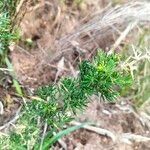Erect shrub, up to 1 m high; stems erect, straight or slightly zigzagging, with short internodes, glabrous; branches and main stems with spines 6– 9 mm long.. Cladodes solitary or in fascicles of 2– 6, subulate, 3– 6(– 19) mm long.. Flowers solitary or in fascicles of 2– 3 on terminal branches; bracts overlapping, broadly elliptic, 1× 0.5 mm, rounded to acute at apex; pedicel 1– 5(– 10) mm long, articulated near base.. Tepals narrowly obovate, 1.5– 3.5 mm long, white with a dark midrib; ovary obovoid, 3-locular with 4– 6 ovules in each locule; style and stigmas short.. Berry black, ± 5 mm in diameter, the dry perianth persistent, 1– 3-seeded.
A small shrub. It can be a climber. It keeps growing from year to year. It grows 1-2 m high. The stems are spiny. These put out new branches each year. The stems are flattened and look like leaves. There are 1-6 in a group. They are narrow. The flowers have a scent. The flowers occur as 1-3 in a cluster. They are small and white with a red stripe. The fruit is a round, black or red berry. It has one seed. It is about 5 mm across.
Erect, spiny shrub, up to 1 m high. Stems erect, straight or slightly zigzagging, with short internodes and many-budded nodes, glabrous. Spines in twos or threes. Cladodes 1-6 per fascicle, subulate, 1-19 mm long. Flowers 1-3 on an apical disc; pedicels 1-10 mm long, articulate near base. Flowering time May-July. Fruit a black berry.
Erect chamaephyte, up to 1 m high. Roots terete. Stems minutely pubescent. Branches either spreading or suppressed (fox-tail habit adopted during dry conditions). Spines straight, often producing spinules. Cladodes filiform. Flowers: apical on branchlets; tepals white with a dark midrib; Jun.-Jan. Fruit a berry.
Erect, spiny shrub, up to 1 m tall, stems sometimes brush-like with spine-tipped branches, spines along stems in twos or threes, straight. Cladodes 1-6 in fascicles, terete, often closely overlapping. Flowers 1-3, shortly stalked, on an apical disc, tepals and filaments spreading. Mainly Apr.-Sept.
Erect chamaephyte, up to 1 m high. Stems minutely pubescent. Branches either spreading or suppressed (fox-tail habit adopted during dry conditions). Spines straight, often producing spinules. Cladodes filiform. Flowers white with a dark midrib.
Erect spiny shrub to 1 m, stems sometimes brush-like, spines in twos or threes. Cladodes 1-6 in fascicles, terete. Flowers 1-3 on an apical disc, tepals and filaments spreading.


